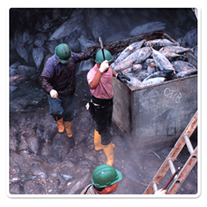 |
|||
Fisheries
Surprisingly, catch statistics from deep-sea fisheries have appeared relatively stable until recently, disguising the decline of individual species as fishermen serially exploit unfished species when faced with diminishing catches. It is now evident that many deep-sea fisheries have collapsed or are beginning to show warning signs of population decline. The inherently low recovery potential of deep-sea fish and the practice of serial depletion (e.g. targeting spawning aggregations of fish) have over-exploited some fisheries to a level which cannot be sustained. With some deep-sea fish species now meeting the World Conservation Union’s (IUCN) criteria for being critically endangered.
|
© All rights reserved Launched 01/09/05
 In the 1950s and 1960s the deep-water fishing industry expanded rapidly, following a decline in catches from the traditional fisheries of shelf seas. This shift in effort also coincided with improvements to fishing gear and the development of large, refrigerated vessels capable of spending extended periods at sea. Since 1950 the mean depth of fishing in the North Atlantic Ocean has increased by 32 m a decade as fishermen continually seek to fish unexploited areas. There has been large declines in the diversity of some fisheries; for example, the diversity of High Seas predatory fishes are estimated to have declined between 10 and 50% since 1950.
In the 1950s and 1960s the deep-water fishing industry expanded rapidly, following a decline in catches from the traditional fisheries of shelf seas. This shift in effort also coincided with improvements to fishing gear and the development of large, refrigerated vessels capable of spending extended periods at sea. Since 1950 the mean depth of fishing in the North Atlantic Ocean has increased by 32 m a decade as fishermen continually seek to fish unexploited areas. There has been large declines in the diversity of some fisheries; for example, the diversity of High Seas predatory fishes are estimated to have declined between 10 and 50% since 1950.